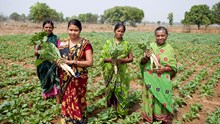
Across the fields of South and Central India, one can often spot the sprawling vines or bushy forms of lablab bean, locally called avarai or sem. This crop, though humble in appearance, carries immense value for farming households. Native to Africa but now naturalized across the tropics, lablab bean (Lablab purpureus L.) has become a trusted companion of farmers because it is nutritious, easy to grow, and well-suited to mixed cropping. The crop is grown for its tender pods, which make a popular vegetable, and also for its mature seeds, which are harvested as pulses. This dual use gives it an advantage over many other legumes.
In India, the bean is cultivated widely in states like Tamil Nadu, Andhra Pradesh, Karnataka, Madhya Pradesh, and Maharashtra. For generations, it has been part of homestead gardens, small fields, and intercropped systems, offering both food security and market value. For farmers looking to diversify, lablab bean stands out because it fits into different agro-climatic conditions and requires comparatively low investment.
Types and Cultivars
Lablab bean comes in two cultivated forms. The first, Lablab purpureus var. typicus, is the vegetable type that produces tender pods consumed as green vegetables. The second, Lablab purpureus var. lignosus, is grown for its dry seeds and consumed as a pulse. Both types are cross compatible, which is useful for breeding and improving varieties.
Research institutes in India have developed several improved varieties suited to different regions. For instance, IIHR, Bangalore has introduced Arka Jay and Arka Vijay, while IARI, New Delhi released Pusa Early Prolific and Pusa Sem 2 and 3. Tamil Nadu Agricultural University has developed an entire series from CO 1 up to CO 14, and University of Agricultural Sciences, Bangalore has released Hebbal Avare 1, 3, and 4. Each variety is bred for better yields, disease resistance, or pod quality, allowing farmers to choose according to their market and soil conditions.
Sowing Season and Methods
The sowing time of lablab depends on the rainfall and region. In most parts of India, it is sown during July to August with the onset of monsoon or during September to November for irrigated crops.
For bushy types, the land is ploughed and prepared to a fine tilth, and beds and channels are formed. Seeds are dibbled with a spacing of about one meter between ragi or sorghum when used as an intercrop. For pole types, often grown in backyards, farmers dig pits of about half a meter in diameter, fill them with decomposed leaves and cow dung, and then sow three to four seeds. Overhead bowers of bamboo or wooden poles provide support for the climbing vines.
On average, 20 to 25 kilograms of seed are required per hectare in pure cropping. Seeds are usually treated with fungicides or biocontrol agents to prevent soil-borne diseases and improve germination. Rhizobium culture is often used to enhance nitrogen fixation and improve crop growth.
Fertilizer and Soil Nutrition
Although lablab bean is a legume and can fix atmospheric nitrogen, it still benefits from a balanced supply of nutrients. Farmers apply farmyard manure at about 12.5 tonnes per hectare to improve soil health. Fertilizer requirements vary under rainfed and irrigated conditions. Rainfed crops may need around 12.5 kg nitrogen, 25 kg phosphorus, 12.5 kg potash, and 10 kg sulfur per hectare, while irrigated crops require double these amounts. Micronutrients like zinc sulfate are also useful under irrigated conditions.
Weed, Water, and Crop Management
Weeds compete strongly during the early stages of growth. Farmers often use pre-emergence herbicides like pendimethalin followed by hand weeding around 40 to 45 days after sowing. In the absence of chemicals, two timely hand weedings are sufficient.
Water management is critical at flowering and pod formation stages. Immediate irrigation after sowing, followed by a life-saving irrigation on the third day, ensures good establishment. Thereafter, watering every 7 to 10 days is recommended depending on soil type and climate. The crop should not experience waterlogging, which can damage roots. Foliar sprays of potassium chloride during moisture stress can help the crop recover.
Pest and Disease Challenges
Like many legumes, lablab bean faces pressure from pests such as aphids, pod borers, and leaf-eating caterpillars. Among diseases, Cercospora leaf spot and Rhizoctonia wilt are common. Integrated pest management practices, such as seed treatment with biocontrol agents, timely monitoring, and safe use of pesticides only when necessary, are the best strategies for sustainable production.
Harvesting and Yield
Harvesting depends on the purpose of cultivation. For vegetable use, tender pods are plucked weekly to maintain quality and encourage more flowering. For pulse production, farmers wait until the pods are fully mature and dry before harvesting. The pods are then threshed, and beans cleaned and stored. Proper post-harvest handling ensures better market price.
Lablab bean is more than just a field crop, it is a resilient companion for farming families, capable of providing vegetables, pulses, and soil improvement. With careful management of sowing time, fertilization, irrigation, and pest control, farmers can enjoy good yields with relatively low input costs. Its adaptability to both backyard cultivation and large-scale farming makes it a versatile choice for strengthening food security and income in rural households. By paying attention to improved varieties and sustainable practices, lablab bean can remain a reliable crop for generations to come.
















